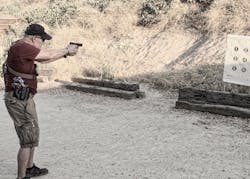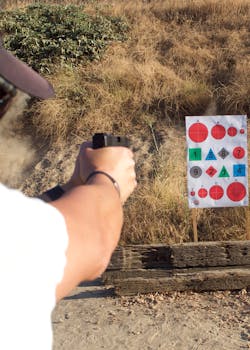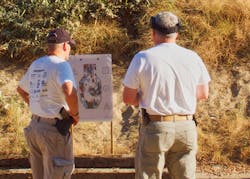Add Dot Torture and Similar Drills Into Your Training
As law enforcement officers, we have a responsibility to maintain a level of competency commensurate with the job. This level of competency has been raised to a new standard by a percentage of the public who have been bankrolled and brainwashed into thinking that it is somehow socially acceptable to assault the very men and women who provide the safety in their communities.
This month’s article focuses on Dot Torture and similar drills, something that an officer can use for solitary practice without breaking thebank. These types of drills answer the question “If I only want to consume a box of ammo a week, what’s a good drill to use?” There are plenty of them. The ones here minimize the amount of real estate, paper and ammo needed for a training session. They should only be used to augment moving and shooting and other skill building training.
Dot Torture is really quite simple. Shooters have a single target with ten dots on it. Each dot has a number and a corresponding instruction. For example, Dot 1 reads: “Draw and fire one string of five rounds for best group. One hole if possible, total five rounds.”
The drill is torturous because if a shooter misses, they must start over again on a clean target. I miss a lot, so it’s a real torture. The drill can be modified to increase the distance or time pressure.
There are variations of Dot Torture, which have similar concepts, but are not necessarily related. The ones I use most commonly have shapes on the targets, and numbers in the shapes. Someone else calls the numbers or the shapes. For this article, I used several different targets from Action Target that worked perfectly for the task.
Training with similar drills
There are several paper products out there with similar training goals. They are not Dot Torture drills, but the idea is to run drills that require the shooter to place their shot into a dot-shaped target under some artificially-induced stress.
One of the better products I used is one from the Shoot Smart Range in Ft. Worth, Texas. This target consists of lettered red bullseyes on the top and bottom rows of the target and numbered shapes that are different colors in the center two rows. Using a shooter/coach system, coaches can call out a color, a letter, a number, a shape or any combination of these. The reverse side of these targets, and the reason I like them a lot, is a torso that includes a sinus cavity, center mass and a pelvic girdle area for barricade and failure practice.
We used these targets at five yards, requiring a draw and accurate shot for each call, unless there was something called that required more than one shot. For example, calling “triangle” or “blue” requires all triangles or blue objects to get a hole.
The best way to use this target is to have at least one other shooter on the line to add pressure to the training. There’s nothing like having someone shooting next to you whose shot breaks almost at the same time as yours. We are talking about decision-making under pressure. This is a higher level of training than square targets on a square range.
For a more traditional Dot target, consider the DEA DOT from Action Target. It consists of six 3.5” dots in two columns. Coaches call out a number and shooters must shoot that number in a timely manner. To add pressure here, shoot enough to force a reload.
It is impossible for officers to train for every circumstance. The best recommendation that I can give is to get trigger time often and vary the training. Training should have specific goals and the goals need to be relevant.
There are four types of firearms training:
- Training in firearm handling skills
- Training using decision-making
- Training in combined skills
- Advanced skills training
These types of firearms training cover most of the skills building training that law enforcement officers do. There is some overlap, like combining decision-making with advanced skills such as team movement, but it is generally not hard to categorize training sessions.
1. Firearm handling skills
Training in firearm handling skills includes fundamental skills building, like learning to load and unload a firearm, sight alignment and sight picture, understanding the capabilities of a firearm and the shooter, grip and shooting platform, and other basic firearm skills. In this area of training, actually firing the gun may or may not be included. When live fire is included in this area of training, it includes muzzle discipline and target analysis.
2. Decision-making training
Training in decision-making includes engaging shoot/no shoot scenarios, selecting and moving to cover, threat identification and prioritizing threats.
Dot Torture bridges the gap between fundamental skills building and force decision-making. Firearms instructors are well-versed in the concepts of vicarious liability and use of force policies when the training covers use of force policies.
In Zuchel v. City and County of Denver, a lawsuit was awarded after a detained individual was shot four times by a Denver officer while they had their hands in the air. The basis for this particular decision was the fact that the agency did not use shoot/no shoot training in their live fire exercises. When force is applied, liability magnets attach when there is evidence that more training should reasonably have been conducted prior to the incident.
In City of Canton, Ohio v. Harris, it was found that a municipality is liable for failure to train its police force when the plaintiff proves that the municipality acted recklessly, intentionally or with gross negligence, and that the lack of training was a factor. In this case, arrestee Geraldine Harris sued the city because she needed medical attention and officers had no training or protocol that required them to summon medical help for an unknown condition.
When any agency has an identified “training gap” it must be addressed. Training must be appropriate, written in policy, and levels and degrees of force, including shoot/no-shoot, must be addressed.
Dot training drills address individual skills in accuracy, reloading and (non use of force) decision-making.
3. Training in combined skills
When we are talking about combining skills, it is usually along the lines of moving and shooting, firearms handling and officer rescue, or defensive tactics and shooting.
When an agency uses combined skills, it is often beneficial to create a multi echelon approach so everyone gets trained in a critical incident scenario. For example, everyone in the agency participates in a combined defensive tactics/shoot scenario. This can be something like a multi target shooting drill on one part of the range, combined with training on handcuffing and joint locks/manipulation on another part. The defensive tactics area can have a live firearm and ammo area that precedes it, and a “make your gun hot” area that follows it. Building clearing can be practiced in the place of defensive tactics.
4. Advanced skills training
As officers leave the live fire “classroom” training areas could be set up for different scenario training for different assignments. Officers report to their respective areas, based on the agency needs. There could be a hostage negotiation drill where members practice setting up throw phones, while critical response (SWAT, etc.) members practice movement and signaling.
This training is multi echelon when supervisors train in crime scene or critical incident management (mass casualty, civil unrest) and dispatchers train on special assignments (critical incident management, DUI checkpoint), and property clerks and Community Service Officers have training tasks as officers report to their respective areas. A single scenario or a series on incidents, part of the Operations Plan, needs to tie this together.
Balance
Which is better, shooting fast or shooting accurately? The answer lies somewhere between. When shooting paper, every exercise has a competency level known as an “acceptable shot group.” Shooting faster opens the group. The idea is to establish a balance based on an acceptable shot group. For Dot Torture, it can be “anything inside the dot.”
It’s well known that if trainers do not reinforce a standard in training, officers will not spontaneously recall the skill in combat. For example, if rifle shooters are taught “elbows down,” but it is never corrected in practice, it won’t happen in real combat.
Just like foul shot practice on the basketball court, one should never end the training with a missed shot. It’s hard, even for the most experienced shooters, to complete the drill with a perfect score. The Dot Torture Drill is humbling.
LEOs are responsible for every round that leaves their gun. Using dots on targets is one strategy for skills improvement. In between regular training sessions with an officer’s agency, there should be some individual training sessions, using just a box of ammo. Try shooting dots.

Officer Lindsey Bertomen (ret.), Contributing Editor
Lindsey Bertomen is a retired police officer and retired military small arms trainer. He teaches criminal justice at Hartnell College in Salinas, California, where serves as a POST administrator and firearms instructor. He also teaches civilian firearms classes, enjoys fly fishing, martial arts, and mountain biking. His articles have appeared in print and online for over two decades.





